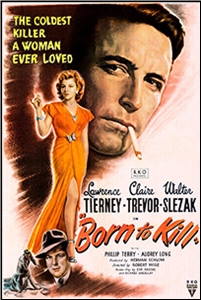Search Results for 'redhead'
Did you find what you wanted ?
Thu 9 Feb 2023
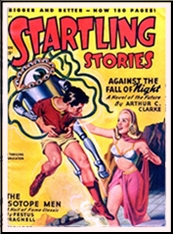
JOHN D. MacDONALD “Ring Around the Redhead.†First published in Startling Stories, November 1948. First reprinted in Science-Fiction Adventures in Dimension, edited by Groff Conklin (Vanguard Press, hardcover, 1953). First collected in Other Times, Other Worlds (Fawcett Gold Medal, paperback original, October 1978).
I don’t imagine that any young SF reader coming across this story in the (at the time) most recent issue of Startling Stories had any idea that the author would become rich and famous a few years later as the John D. MacDonald you and I know today as, for example, the author of the series of mystery novels for which he is most remembered, thous about “salvage expert†Travis McGee.
Nor did, I suppose, those fans of the Travis McGee books happen to know that he started out writing SF stories — as well as mysteries — for the pulp magazines of the late 1940s. I don’t know if all of his early SF work were later collected in Other Times, Other Worlds (1978), but there are sixteen of them, and ones MacDonald much have felt worth reprinting at the time.
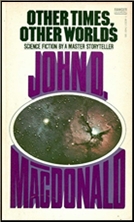
“Ring Around the Redhead†is, well, one of them, and it begins with a defendant in court having been accused of murdering his next door neighbor, and in a most vicious fashion: the dead man had been decapitated as if by a mammoth pair of tin snips. When the defendant, an amateur tinkerer, gets to tell his story to the jury, it really is quite a story. Having strangely discovered a mysterious ring in his workshop in the basement, he learns by trial and error that by reaching through it, he can bring back, among other items, valuable jewels, for example. (This is why he is seen arguing with the neighbor, who has discovered this.)
One day, then, he brings a beautiful girl back through the ring, a redhead, who is wearing next to nothing but strangely still something.
Hence the title of the story, which has no other objective than to be fun and amusing. No deep scientific principles are discussed in this tale. What this tale reminded me of, more than anything else, are the SF stories very common back in the early 30s, based on speculation but not a whole lot of down-to-earth physics – but, in this case, a tale that’s a whole lot better written.
Nonetheless, without a solid background in science, JDM must have decided that science fiction was not a field where he had much of a future. Considering how things worked out for him, this was a wise choice.
Mon 26 Apr 2021
PERRY MASON “The Case of the Restless Redhead.†CBS, 21 September 1957 (Season 1, Episode 1). Raymond Burr, Barbara Hale, William Hopper, William Talman, Ray Collins. Guest Cast: Whitney Blake, Ralph Clanton, Gloria Henry, Vaughn Taylor. Teleplay: Russell S. Hughes. Based on the novel by Erle Stanley Gardner. Director: William D. Russell. Currently available on DVD and streaming on Paramount Plus.

When a waitress comes home from work, she finds a gun in her cigarette case sitting on her coffee table. In her shoes, what would you do? I’m sure you would call Perry Mason’s office, the same as either you or I would, am I right? Even though it’s late at night, she heads out by car to meet him in his office.
She’s followed by a car driven by a man with a pillow case over his head, with holes cut out for his eyes. When he tries to run her off the road, she uses the gun to fire two shots at him. She misses, but one shot hits the car, which seems to swerve off the road. Telling her story to Mason, he decides to drive out to the spot where all this took place.

Would you be surprised if I told you the police are there first? You shouldn’t be. They are, and they’re trying to find a way to hoist a car up a steep embankment. The driver of the car, found inside, Mason is told, is dead. He has been fatally shot in the head.
The Perry Mason novels always begin with extremely catchy openings, and this first episode of the Perry Mason TV show follows the pattern to perfection. Other familiar themes follow. Mason is not sure whether to believe the girl’s story or not, but when Lt. Tragg comes calling, he has no recourse but to take her on as a client. Della Street is there to comfort her and provide everyone with coffee. (It is now three o’clock in the morning.)

As for the gun, Paul Drake soon discovers that is one of a pair, both bought by the same person at the same time. Mason maneuvers himself into the case personally by obtaining the other of two guns, putting a notch in the barrel with a small file, then shooting it a couple of times at the scene of the crime.
This little trick comes in handy at the preliminary hearing, which ends up with D. A. Hamilton Burger completely befuddled. Now I posit this, if I may. Can you think of a better story line than this to demonstrate to TV audiences everywhere in the country what the rest of the series is going to be like, based on this very first episode? Nor can I.

This synopsis so far does not include the following: Perry’s client was recently acquitted of stealing some jewelry from a movie star who just happens to be the fiancée of the man who bought the two guns, who is being blackmailed by the former husband of the movie star who claims the divorce never went through, and the husband and wife who run the motel where the theft of the aforementioned jewelry took place act very strangely when Mason comes asking questions.
And do you know what? You can actually follow the plot, even with all of these players, and without a scorecard.
Sun 2 Apr 2017
FIRST YOU READ, THEN YOU WRITE
by Francis M. Nevins
I can hardly believe it but we are less than six months away from the 60th anniversary of the debut of Perry Mason the TV series. It was a Saturday evening, September 21, 1957, and among the millions of viewers whose sets were tuned to CBS at 7:30 P.M. Eastern time was a bookish 14-year-old, just beginning his second year of high school, who had discovered and gotten hooked on Erle Stanley Gardner’s Mason novels several months earlier.
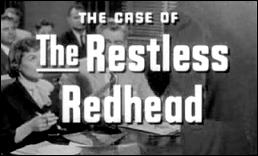
For the next few years I watched the program religiously, catching most of the finest episodes and almost all of those that were at least nominally based on Gardner’s novels. By the time I began dating on Saturday nights the series had become humdrum and routine, at least to my taste, but it remained in prime time for an amazing nine seasons, and countless viewers still identify Gardner’s characters with their TV incarnations: Raymond Burr (Mason), Barbara Hale (his secretary Della Street), William Hopper (private detective Paul Drake), William Talman (DA Hamilton Burger), and Ray Collins (Lt. Tragg).
To mark the occasion, if a bit prematurely, I’m going to devote most of this column to the first episode aired and the book it was taken from.
***
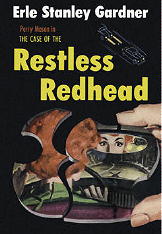
First, the book. The Case of the Restless Redhead (1954) opens with Mason happening upon a trial for larceny in suburban Riverside. Evelyn Bagby, a near-broke waitress with Hollywood dreams, is accused of having stolen $40,000 in jewelry from the trunk of Irene Keith, a wealthy businesswoman on her way to Las Vegas to be bridesmaid at the wedding of movie star Helene Chaney and boat manufacturer Mervyn Aldrich.
Seeing that assigned defense counsel Frank Neely is out of his depth cross-examining the witness who claims to have seen Bagby open the trunk, Mason over lunch offers the young man a few pointers. That afternoon Neely demolishes the prosecution witness and wins a verdict of acquittal. Bagby comes to Los Angeles to thank Mason and they discuss whether she’s entitled to compensation from Keith, who signed the complaint against her.
Bagby suggests that she might have been framed for the jewel theft because she’d recognized a newspaper photo of Chaney’s former husband as the phony drama coach who had swindled her out of her inheritance several years before and whom she had called, demanding restitution. Mason gets her a job as waitress at the Crowncrest Inn, which is on a mountaintop connected with the metro area by a narrow and desolate road.
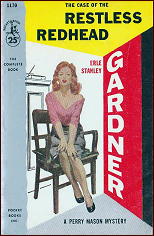
That evening Bagby calls Mason and claims to have found a .38 Colt Cobra with a 2-inch barrel planted in her room at the Inn. Mason tells her to meet him at a certain restaurant, bringing the gun. When they get together she says she was attacked on the mountain road by a man wearing a pillowcase mask, at whom she fired two shots with the .38. Mason reports to the authorities. When he, Della, Bagby and an officer visit the scene of the incident, they find a wrecked car and inside it a dead man, shot in the head and wearing a pillowcase mask.
When it’s discovered that the mask came from the Crowncrest Inn, and that the dead man was in fact the fake drama coach who had cheated her, Bagby like all Mason’s clients gets charged with murder. Much of the rest of the novel takes place at the preliminary hearing where Mason defends her.
Looking at the plot through a microscope reveals flaws here and there. As the hearing begins, the decedent’s body is identified not by the police or a medical examiner but by one of the characters, who isn’t needed as a witness but whom Gardner needs in the courtroom later.
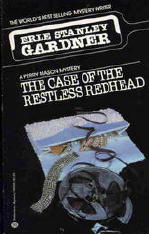
At the end of the book Mason “deduces†a good bit of the plot without a shred of evidence to go on. There are other holes too but they didn’t faze Anthony Boucher and I didn’t let them bother me much either. Boucher in the Times Book Review (7 November 1954) said: “Some intricate defensive maneuvers to confuse the ballistic evidence may baffle not only the judge and the prosecution but also the reader; you’ll have to keep your mind as sharp and devious as Mason’s own to follow this one, but it’s a wonderful roller-coaster ride.â€
For the sake of those who don’t want to have the novel spoiled by my saying too much about the plot, I’ll let the cat out of the bag in a paragraph which will remain hidden unless you click on it. Here, kitty!
***
The telefilm with which the Mason series debuted keeps the ballistic maneuvers pretty much intact but simplifies the novel in almost every other way imaginable. Irene Keith is dropped, as are fledgling lawyer Frank Neely and his fiancée and the whole larceny trial with which the book opens. The rationale for the titular adjective, that Bagby likes to keep moving from one place to another, winds up on the cutting-room floor, leaving us with nothing but alliteration for its own sake.
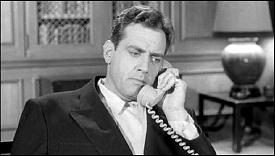
Bagby’s bullets, which in the novel complicate the plot by striking certain objects, on the small screen hit nothing. The ballistic testimony which dominates several chapters of the novel is cut to the bone. But with something like 52 minutes of air time to do justice to a full-length book, what option other than cutting was available?
All in all, adapter Russell S. Hughes did a creditable job. It was the only teleplay he wrote for the series. Before the first season’s end, he had died. Age 48. Cause unknown.
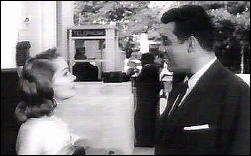
Raymond Burr as Mason is spectacularly slender, having reportedly lost between 60 and 100 pounds while preparing for the part, and smokes up a storm, as do several other characters including his client, who is seen finding the planted .38 in her cigarette box. The client was played by lovely Whitney Blake (1926-2002), who will also pop up later in this column.
Prominent in the cast were Ralph Clanton (Mervyn Aldrich), Gloria Henry (Helene Chaney) and Vaughn Taylor (Louis Boles). The first several minutes could be mistaken in dim light for film noir, thanks especially to ominous background music by the never-credited Ren Garriguenc (1908-1998), whose talent (when he wanted to exercise it) for sounding like his CBS colleague Bernard Herrmann has fooled experts. Bits and pieces of Herrmann music are heard here and there but they are few and far between.
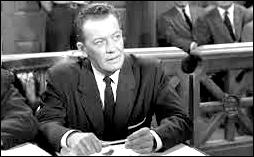
About the director, William D. Russell (1908-1968), not a great deal is known. He began making movies after World War II at Paramount, where he helmed several “heartwarming†comedies. During a pit stop at RKO he made Best of the Badmen (1951), a Western starring Robert Ryan, Claire Trevor, Robert Preston and Walter Brennan, which can be seen complete on YouTube.
Like so many directors of his generation who saw their careers crumbling thanks to TV, he embraced the new medium and began specializing in situation comedies, directing 61 episodes of Father Knows Best before moving to CBS. There he took up more serious fare, notably a few early episodes of Gunsmoke and 28 of Perry Mason.
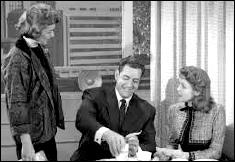
Afterwards he went back to the sitcom, directing 48 segments of Dennis the Menace and 128 of the 154 episodes of Hazel (1961-66), starring Shirley Booth as live-in housekeeper for an affluent family, the female head of which was played by — I told you she’d pop up again! — Whitney Blake. (Whether she arranged for Russell to come aboard, or vice versa, or whether it’s just a coincidence, remains what Russell concentrated on for a few years and then dropped: a mystery.) Less than two years after the series was cancelled — which happened the same year Mason was cancelled— Russell died. Age 59. Cause unknown.
***
On top of all his novels and stories and travel books and Court of Last Resort pro bono work on behalf of the wrongfully convicted, Erle Stanley Gardner kept up a gargantuan correspondence. One of his correspondents was Harry Stephen Keeler (1890-1967), the wackiest wackadoodle who ever sat down to a typewriter. Several of Harry’s multi-colored “Walter Keyhole†newsletters, assembled and arranged by me in The Keeler Keyhold Collection (2005), include quotations from ESG’s letters to him.
In one of them, probably dating from the late Fifties or early Sixties, Gardner alluded to the fact that both his mother and Keeler’s happened to have the same first name; an odd one to say the least. “Now ‘Adelma’ [Keeler wrote] is not a recognized name….Name experts say that it is undoubtedly an artificial synthesis, or fusion, of the names ‘Adeline’ and ‘Thelma’.â€
Why not Adelaide, or Selma? After comparing notes, the two discovered “that a grandfather of each had been in the Civil War†(presumably on the same side) and concluded that “over some camp fire their grandfathers must have met, and talking of possible ‘odd’ names for girl-children, agreed…to name their first daughters ‘Adelma’.†Well, maybe. Anyway it’s a good story.
Mon 11 Apr 2016
REVIEWED BY JONATHAN LEWIS:

THE REDHEAD FROM WYOMING. Universal International, 1953. Maureen O’Hara, Alex Nicol, William Bishop, Robert Strauss, Alexander Scourby, Palmer Lee, Jack Kelly, Jeanne Cooper, Dennis Weaver, Stacy Harris. Director: Lee Sholem.
For the first twenty minutes or so, I thought that The Redhead from Wyoming was going to be a much better movie than it ultimately turned out to be. There was something particularly dynamic about Maureen O’Hara’s screen presence, including her brightly colored clothes that gave me reason to think that this Universal International release might be something of a minor forgotten gem.

Sadly, that didn’t turn out to be the case. Although it’s not without its charms, the movie is simply just another lackluster 1950s Western that ends up playing it on the safe side. The result being that the movie is likely to languish in relative obscurity.
In many ways, the plot is less a cohesive whole than a mishmash of tropes. Range war between the local cattle baron and homesteaders (check); drifter with a tragic past turned lawman (check); the flamboyant female saloon proprietress with a dark past and heart of gold (check); the power mad villain who wants to catapult himself into the governorship (check). You get the picture and can fill in the blanks from there.

What makes The Redhead from Wyoming somewhat interesting is the rather overt proto-feminist messaging. O’Hara portrays Kate Maxwell, a strong-willed saloon owner caught between three powerful men: Sheriff Stan Blaine (Alex Nicol), cattle baron Reece Duncan (Alexander Scourby), and local power broker Jim Averell (William Bishop). What these three men don’t realize is that Kate has more than good looks. She’s got brains and she’s willing to use them. She’s pretty handy with a gun too. Sadly, the supporting cast, let alone the lifeless male characters and plot, doesn’t do her character justice.
Fri 23 Feb 2024
Posted by Steve under
Reviews[7] Comments
Reviewed by TONY BAER:
JAMES GUNN – Deadlier Than the Male. Duell Sloan and Pearce, hardcover. 1942. Signet #709, paperback, 1949. Forthcoming from Stark House Press, softcover, April 2024 (intro by Curtis Evans). Film adaptation: Released as Born to Kill (RKO Radio Pictures, 1947, with Claire Trevor, Lawrence Tierney, Walter Slezak).
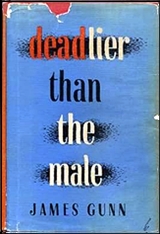
Legend has it that there was a time where men were men and women were women. James Gunn is here to tell you that that time, if it ever existed, wasn’t in 1942.
Sam Wild is a man. A wild man, a man’s man, a ladies man. He’s redheaded, rough and tough and he smells like sweat.
Mrs. Krantz runs a boarding house and lives for the lurid stories of her only friend: Laura Pollicker.
Laura is a marginally wealthy, flaccid gigolo-monger, in ruffles. Picture Bette Davis’s Baby Jane trying to seduce you. She comes bearing gifts.
Laura regales Mrs. Krantz with legendary lovemaking with her new beau: He’s redheaded, rough and tough and he smells like sweat.
Sam Wild finds his benefactor with another gigolo, and goes wild, killing Laura Pollicker as well as his rival.
The cops have no clues. But Mrs. Krantz is determined to sniff out the killer: “Laura was all I had. Laura and the bottle. There’s nothing I can do for the bottle, but I won’t let Laura down.”
There’s a pretty funny scene where Mrs. Krantz tracks Sam Wild down, sits two rows behind him at the theater, trying to sniff him out, leans over the dividing row, sticking her huge ass high in the air, blocking the view of the other patrons, inhaling deeply at the smell of her prey, exclaiming: “Laura! I found him!”
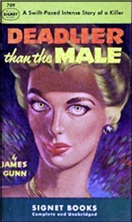
Sam Wild escapes from Mrs. Krantz, only to be ensnared by Helen, a blonde bombshell. And Sam, for all his animal force, realizes he’s lost to “the most beautiful smiling thing I ever saw, with a body like honey and a face that smiles. She sits and smiles and swings her legs, above me, above the world, knowing she’s better than anybody ever was, sure that she and her kind own the earth we live on. And they do. And she hates me.”
But “Helen had had about enough of men sobbing on beds. She slapped his face, hard. He cringed as she leaned over him.”
Helen is a femme fatale for the ages. She destroys everyone in her orbit and emerges unscathed, nay better, stronger, richer, more powerful than ever, by the end. A school of weak men drowned in her wake.
—–
I liked the book. Didn’t love it. But then again I already knew the femme fatale was deadlier than the male. It may have been news in 1942, but it’s a pretty well trodden path today. The reviews of the day showed the book by this 21 year old writer blew people away: “This Stanford Senior writes better than Cain ever wrote”, said John Selby in his syndicated book review. The philosopher Gilles Deleuze named it his favorite of the first 1000 serie noires.
So ‘people’ love it. But it’s always hard to know what history was like before it happened. I’ve already seen Body Heat and many more like it. So I’m not surprised. But if readers of 1942 were used to Goldilocks, they had another think coming. A think which must have felt a bit like when Mrs. Krantz, “with all her might … jabbed up between his legs with her hatpin.”
Tue 29 Aug 2023
Posted by Steve under
Reviews[5] Comments
Reviewed by TONY BAER:
LAURA LIPPMAN – Sunburn. William Morrow, hardcover, February 2018; trade paperback, July 2018; mass market paperback, June 2019.
Adam Bosk, a Baltimore PI, has been hired to track down Polly Costello. She’s a pretty redhead, mid-30’s.

He finds her in the High Ho Tavern in Belleville, Delaware. He sits at the bar and tries to connect. She’s got a sunburn.
Polly’s first husband, Ditmars, was a wife-beating arson detective. Ditmars made an unholy alliance with an insurance broker to underwrite a bunch of insurance policies and burn stuff down, splitting the proceeds.
Polly wasn’t given much of an allowance from Ditmars, so she entertained herself going to the library film series. One day, the library put on a James M. Cain series, showing Mildred Pierce, Double Indemnity and The Postman Always Rings Twice. But it was Double Indemnity that got her attention. She loved it. And read the book, becoming a Cain acolyte.
Polly then took out a big policy on her husband, made their daughter the beneficiary, and made her husband a big turkey dinner, stuffing and mashed potatoes filled with crushed up sleeping pills, and homemade apple pie with whipped cream whipped by hand.
That night the same hand that did the whipping grabbed a huge kitchen knife and plunged it deep into her husband’s heart.
She was later pardoned by the governor among a slew of other murderers suffering from battered woman’s syndrome. The governor’s office did a crappy job of vetting her case (the premeditation, the insurance), and later regretted her pardon — but too late. She was free.
The insurance broker never got his kickback. And hired PI Adam Bosk to spy on her and find out where she was keeping the money.
But Bosk ends up falling for Polly, just like every other man she’s ever wanted, or needed, or used. And Bosk throws in with Polly, casting both his client and his caution to the wind.
Polly is even more complicated than she appears to be. And darkness descends. Enveloping Adam Bosk and all else in Polly’s orbit.
======
It’s a very well-done modern take on the classic noir tale. If anyone is wondering if noir is still a viable thing, check it out. It’s also interesting to see the femme fatale from a modern female writer’s perspective. She’s ambiguous, lusty and sexy as hell. But she’s also three dimensional and at the end of the day, you can empathize with her in a way that James M. Cain and many of the old timey noir practitioners were incapable.
It’s a legit noir. And it’s from 2018. So there. It can still be done. And with a fresh take, too. Thanks to Juri Nummelin for the recommendation: https://pulpetti.blogspot.com/2018/07/laura-lippman-sunburn.html
Mon 2 Jan 2023
MARGARET SCHERF – The Elk and the Evidence. Rev. Martin Buell #4. Doubleday Crime Club, hardcover, 1952.
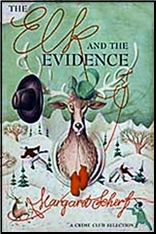
Reverend Martin Buell is an Episcopal rector in Farrington, Montana, but some how or another, he always seems to find himself caught up in yet another murder case, The Elk and the Evidence appearing right in the middle of his crime-solving career. Margaret Scherf, the teller of his adventures, as well as those of her other series characters, Grace Severance (4 books), Emily & Henry Bryce (4 books), Lt. Ryan (2 books), as well as a sizable number of standalones, is known for her light humorous approach to writing detective fiction, and the example at hand is no exception.
The case is threefold. (1) A package of elk meat given to Buell as a gift unaccountably contains a man’s toe. (2) A hunter who was a member of a large hunting party has gone missing. And (3) a girl coming to Montana to vet out a wealthy man as possible marriage material encounters two men in hunting clothes leaving a third man overnight in a lower train berth while on her way home.
Are the three incidents connected? You bet they are.
The humor comes quietly in almost every page of the first half of the book – only a smile perhaps, but most detective novels have none. The smiles don’t come from wacky behavior, but largely from Buell’s observation of people and the natural order of things in a small town in which everybody knows everybody else. The girl, a natural redhead, has to be put up in a widower’s spare bedroom, for example, which causes a lot of curiosity.
This is a lot of fun to read, as you can imagine, but unfortunately the detective end of things is, to coin a word, disappointing. Reverend Buell tries, but as as a man of the cloth, nothing more, he has no way to conduct any kind of proper investigation. The conclusion tries to tie all the preceding events together, but where all of the facts relevant to a motive came from, it is hard to say. And why the man’s toe was removed is even harder to explain. I didn’t even try to follow.
The Rev. Martin Buell series –
Always Murder a Friend. Doubleday 1948.
Gilbert’s Last Toothache. Doubleday 1949.
The Curious Custard Pie. Doubleday 1950.
The Elk and the Evidence. Doubleday 1952.
The Cautious Overshoes. Doubleday 1956.
Never Turn Your Back. Doubleday 1959.
The Corpse in the Flannel Nightgown. Doubleday 1965.
Tue 13 Apr 2021
Posted by Steve under
Reviews[5] Comments
REVIEWED BY DAN STUMPF:
ROGER BLAKE (John Felix Trimble) – Commie Sex Trap. Art Enterprises/Boudoir, paperback original, 1963.

Let me confess up front, I cannot resist a book with a title like Commie Sex Trap. And having said that, I might add that back in my college days I was assigned books that seemed to me no better-written than this, and certainly much duller.
Not that Commie Sex Trap is much good, but there are indications here and there that Blake/Trimble could write with some style, if the spirit moved him. Lines like: “Long arms moved up to his neck and pulled him down to the twisting mounds of flesh that played an undulating game of mobility with her restive body.†Show flickers of talent, and the story is set up reasonably well.
Ah yes, the Set-Up. Sgt Joe Guthrie works in the decoding section of US Army headquarters in West Berlin, and he’s involved with Erika Lang, a blonde fraulein with parents in the Eastern sector. The relationship is against Army regs, but these kids are in love and whaddaya gonna do?

Well it seems somebody knows just what to do. Guthrie shows up one night at Erika’s room, and walks into a situation straight out of Woolrich: Erika is missing, her clothes and personal effects are gone, and the bed they shared is occupied by a voluptuous American redhead who says she’s been there for weeks — a story backed up by the landlord, even under duress from Joe. Then, before you can say achtung, the landlord’s killed and Joe is in the clutches of Russian spies who offer to return Erika and keep Joe from being fingered for murder — in exchange for decoding room secrets.
From here on out, it reads like a Men’s Sweat magazine, as Joe bounces from improbably-cantilevered seductresses to neolithic Russian agents snarling threats in fluent gutteralese and playing patty-cake with our hero’s face.
As for Sex… well there isn’t any till page 90 of a 160-page book. Up to then, it’s just a plethora of scantily-clad ladies flinging themselves, knees akimbo, at the manly GI, only to have things interrupted by spies jumping out of closets and the like. We get a guest appearance of a Rosa Klebb clone out of From Russia with Love, a bit of torture, some slug-festing, and all the sort of thing teenage minds of all ages once considered “adult.â€
As such, Commie Sex Trap is just about perfect, but readers with a mental age over 15 should approach with caution.
Wed 27 Jan 2021
S-F YEARBOOK: A Treasury of Science Fiction, Number One, 1967. Overall rating: 2½ stars.
JOHN D. MacDONALD “Ring Around the Redhead.†[First published in Startling Stories, November 1948.] An inventor discovers a doorway to other dimensions, then must defend himself in court when it proves dangerous. Readable in spite of weak plot. (2)

CHARLES L. HARNESS “Fruits of the Agathon.†[First published in Thrilling Wonder Stories, December 1948.] Novelette. Agathon is a word from the Greek meaning death of an individual planned for the good of society. Confusing, disturbing, and unreadable, but much better than average. (4)
MARGARET ST. CLAIR “The Unreliable Perfumist.†[First published in Thrilling Wonder Stories, February 1953.] Intrigue between a family of Martian perfumists. (0)
GORDON R. DICKSON “Show Me the Way to Go Home.†[First published in Startling Stories, December 1952.] Two Cuperians need the help of a talking at to escape Earth. (1)
RAY BRADBURY “The Irritated People.†[First published in Thrilling Wonder Stories, December 1947.] Warfare is conducted by radio music, confetti, and mosquitos. (2)
MARGARET ST. CLAIR “The Stroller.†[First published in Thrilling Wonder Stories, August 1947.] About strange creatures from Venus. (0)
GEORGE O. SMITH “Journey.†[First published in Startling Stories, May 1948.] Space pilot has to come up with FTL theory to prove he traveled to Alpha Centauri. (3)
EDMOND HAMILTON “The Knowledge Machine.†[First published in Thrilling Wonder Stories, June 1948.] Two men take over an inventor’s discovery that speeds learning electronically. (3)
THEODORE STURGEON “The Sky Was Full of Ships.†[First published in Thrilling Wonder Stories, June 1947.] Strange visitors to Earth are concerned about the use of atomic power. A famous last line. (3)
– August 1967
Fri 24 Jul 2020
Posted by Steve under
Reviews[5] Comments
REVIEWED BY TREVOR TRILLION:
BRETT HALLIDAY – She Woke to Darkness. Mike Shayne #25. Torquil/Dodd Mead, hardcover, 1954. Dell #867, paperback, 1956; reprinted as Dell D446, paperback, 1962.
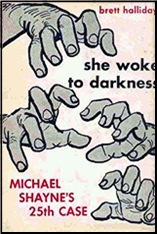
The 25th case for Michael Shayne, who finally appears in Chapter 11. Since 1938, Shayne arrived in the first sentence of 21 books. I will mention some of the plot in this review, but truthfully, I am compelled to talk about significant changes in Davis Dresser’s writing style; his sudden desire to “crank up” the sexiness and violence in dialog among a lower class of despicable characters.
Brett Halliday, the major character, attends a Mystery Writer’s Convention in NYC, 1953. In the author’s foreword, Dresser, as Brett, states that Mike Shayne’s “previous 24 books were written in Third person by meâ€, but now this case has happened to me,’ and in first person. Brett becomes the #1 murder suspect.
Surrounded by contemporary writers both real and fictitious, Brett overhears harsh criticism, describing him as an ”out-dated old timer”, a hack writer… doubt if he ever reads anything but his own stuff… what a bore that must be”. From peer pressure, style changes begin.
As usual, the cognac flows throughout pages 11 to 25. This boozing allows Brett to meet his newest admirer, Elsie, the heavy-drinking, hot babe, mystery-writer-wannabe. She’s writing a True Crime murder mystery based on her own horrible experience three months ago, and would Brett please read it to suggest a continuation?
They go back to her place, Brett gets the original 56-pages, they drink more, kiss more, as Brett begins his new-found romantic style. He lights two cigarettes (a la film Now, Voyager, 1942) “… her eyes dancing, ‘Darling’. It was a long kiss…â€. Elsie gets a phone call then kicks Brett out at midnight. Guess who the Police find strangled at 2am?
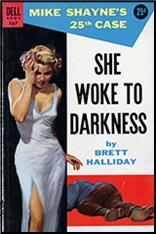
Elsie had commented that she read all 24 Shayne mysteries, in order, and considers Mike Shayne, ” …so real, not like Philo Vance (the 1920s-30s fictional crime solver). … Characters like Philo remain so exactly the same book after book, year after year. They never change.”
Brett’s words here are his own, sarcastic comment upon his Shayne, because for 24 books Shayne is one that has remained the same… and sadly, Dresser knows it. Shayne never develops from his hot-headed ways; his cognac for breakfast, lunch, dinner, cognac before driving and taking Lucy Hamilton’s affections for granted. (Spoiler alert: Readers will see changes in books 25 – 31)
Halliday now reads Elsie’s first chapters where several cruder types, not found in earlier Shayne novels, are described using their new names, but keeping the true facts in the case.
1. Aline, is Elsie’s new name… “She Woke To Darkness” alone (?) in a hotel bed with a two-dollar bill stuffed in her rolled-down nylons. She’s become a “two-dollar whore,” has alcoholic black outs. She remembers nothing about last evening.
2. Mr. Unknown, an unattractive, dead guy with his throat slashed… on the hotel room floor.
3. Ralph, the suave, ever-horny, ladies’ man.
4. Doris, the plump, blonde, that opens her front door at midnight, for Ralph.
5. Dirk, the (again) alcoholic-black-out, married guy, smooched, then was rejected by Elsie, and he can’t remember anything either.
6. Gerry, who will swear Elsie is guilty of murder, or could her body keep him quiet? New vocabulary: “he pressed his pelvic bone against hers‒ (This was probably pretty racy dialog in 1954.)
7. Brett Halliday, who is described thusly:, “drunk as a coot, has-been loser, one-eyed bastard, He writes those lousy books about a redhead Miami detective.”
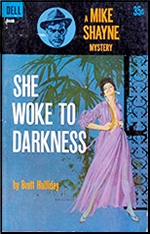
Shayne flies into NYC becoming desperate character #8 because murder suspect #1, Halliday, goes missing. Two murders and now Halliday might be number three? Shayne visits suspects and lays on the new, 1953 charm, “Give me his name or, so help me, sweet Jesus… I’ll kick your face into a pulp that none of your women will ever recognize again.”
“Tell him…” sobbed Estelle, “He’s capable of anything.”
Shayne yells, “I’m going to beat his God-damned brains out.” (Yikes, Brett, Mike, the Lord’s name taken in vain? That’s a change!)
In conclusion, the romance ended in chapter three, everybody lies, and kidnapped Brett is beaten senseless. The cops were stumped, Shayne solves it and Mr. Unknown never spoke a word. Usually the victim has a role somewhere in a Shayne novel… not here.
Rest assured Readers, these changes affect the next few Dresser novels. After 24 shy novels along the lines of, “she had a small waist, her skirt rose above her knee, her curves…†Those days are over. In #26, Death Has Three Lives, Shayne demonstrates undying love for kidnapped Lucy. Violence abounds in #27, Stranger In Town, Shayne is beaten to a pulp and still kills a guy. #30, Shoot The Works, we meet Kitty and Lola; two of the horniest, hot young ladies yet. But Shayne is still loyal to Lucy.
Finally, in 1958, Dresser rewrites 1946’s Dinner At Dupré’s, into an expanded version titled, Murder and the Wanton Bride. Dresser ends his writing career with #31, a “Wanton Bride” to surpass all previous babes; more desirable and provocative than any McGinnis cover art. (Chapter 8 is devoted to her.)
Viva the new 1954-style Brett Halliday!
















